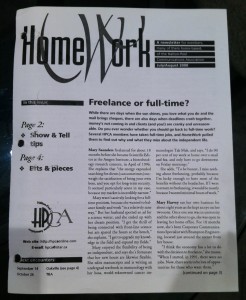 While cleaning out my files, I came upon a stack of back issues of a four-page print publication I used to write and produce as a volunteer for one of my groups for entrepreneurs.
While cleaning out my files, I came upon a stack of back issues of a four-page print publication I used to write and produce as a volunteer for one of my groups for entrepreneurs.
Before recycling the pile, I went through it and kept a copy of each issue, filing them neatly in a binder. (This is part of the reason I need to declutter fairly often; you’ll find a sample of just about everything I have ever written somewhere in my office!)
As has happened, sadly, to many a print publication, this one no longer exists. It was a controversial decision that I won’t get into here. Suffice to say a number of us mourned and still feel its loss, despite its eventual replacement with an electronic version.
As I flipped through the issues, enjoying the smooth touch of the paper and the simple, clean design (by one of the group’s talented graphic designers), I was pleased to see that the content stood the test of time. We have a number of talented writers in the group who contributed, and it showed.
- The newsletter covered useful tips for things like riding out the peaks and valleys of solo work, cold calling, dealing with “scope creep” and maintaining a professional business with children home during the summer.
- The newsletter introduced new members and shared updates on projects in which existing members were involved.
- If you couldn’t make it to one of the regular meetings, you knew you’d be able to read about it in a summary that was the next best thing to being there.
Don’t get me wrong; e-newsletters can be great, and I subscribe to quite a few. The best make sure the content is king, with useful guidance on whatever the newsletter topic happens to be.
And they are regular; if the newsletter is monthly, you get one every month. Although many people think an e-newsletter has to be flashy, a strictly text newsletter is fine; looks aren’t as important if the content is there.
But what’s so great about print?
- It’s portable. You can read it on the bus or subway, and take it home to share with your family.
- It’s easy to keep. You can file it and refer to it later, as our independent communicators often told me they did.
- It’s easier on the eyes than staring at a computer screen.
- It can be more economical for businesses than something employees read online, since many times they will print it out at work anyway, at higher expense than the bulk printing of hard copies.
- Not everyone has a computer. I know, it seems like we all do, but what about truck drivers? People who work in a mine or in construction? They may have shared access to a computer at certain times, or use a smartphone or other mobile device that isn’t the best place to view an online newsletter.
Respected communications expert Dr. TJ Larkin notes that “The Web is best for short, quick, information retrieval. The Web user is a hunter: leaning forward, senses pricked, visually aware, searching and eventually tracking down the targeted information. This is a great mental state for searching but a much poorer one for comprehending.”
Dr. Larkin says companies should “think paper” when communicating things like a major change to benefit plans, a big strategic change in business direction or a new software application.
“Messages that are new, long, and complicated belong on paper, not on Web pages,” he says. “Paper’s strength is comprehension. People use the Web — they read paper.”
(Updated in 2017.)

Yup, yup, yup! That newsletter is still missed. There was something so intimate, personal & comforting about getting it in the mail & reading every bit of it over lunch, then filing it away. Oh & I would re-read it from time to time, not something I ever do with an e-newsletter.
Sue,
I love this post. My first corporate communication management job was as editor of a publication. I loved it! That publication was the springboard from which I rose in the company. It led me to explore and write about every part of the organization, to strategic alliances and friendships with people throughout the company, and provided me with a terrific creative and cerebral outlet.
I tell my PR students at Towson University that if they get a chance to edit a publication, jump on it. I found it to be a completely fulfilling job and a great start on a much broader communication career. I tell them that if a publication needs an editor, say without hesitation, “I’m yours!”
Les
Let me chime in and say how much I appreciated your post, Sue, and how much I miss editing newsletters.
Gloria, I was especially thinking of you when I wrote this. Les, I feel the same way about the opportunity to explore and write about a company. Ron, at least you know that bi-weekly one you started lives on! Thank you all for taking the time to comment.
Yes, Sue, that newsletter is missed. You did a terrific job with it for so many years. Over the holidays I was cleaning out MY files, and decided to save one of the “classic” issues – the one written just after Sept. 11, 2001.
Thanks, Donna! Wasn’t it interesting to reread that issue, and the thoughts we had all expressed on our discussion board?